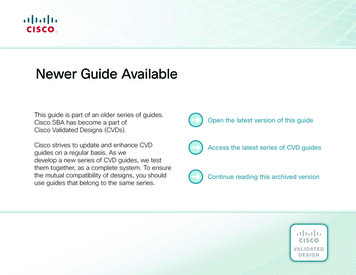
Transcription
WAN Design OverviewFebruary 2013 Series
PrefaceWho Should Read This GuideRelease SeriesThis Cisco Smart Business Architecture (SBA) guide is for people who fill avariety of roles: Systems engineers who need standard procedures for implementingsolutionsCisco strives to update and enhance SBA guides on a regular basis. Aswe develop a series of SBA guides, we test them together, as a completesystem. To ensure the mutual compatibility of designs in Cisco SBA guides,you should use guides that belong to the same series. Project managers who create statements of work for Cisco SBAimplementationsThe Release Notes for a series provides a summary of additions andchanges made in the series. Sales partners who sell new technology or who create implementationdocumentationAll Cisco SBA guides include the series name on the cover and at thebottom left of each page. We name the series for the month and year that werelease them, as follows: Trainers who need material for classroom instruction or on-the-jobtrainingIn general, you can also use Cisco SBA guides to improve consistencyamong engineers and deployments, as well as to improve scoping andcosting of deployment jobs.month year SeriesFor example, the series of guides that we released in February 2013 isthe “February Series”.You can find the most recent series of SBA guides at the following sites:Customer access: http://www.cisco.com/go/sbaPartner access: http://www.cisco.com/go/sbachannelComments and QuestionsIf you would like to comment on a guide or ask questions, please use theSBA feedback form.February 2013 SeriesPreface
Table of ContentsWhat’s In This SBA Guide. . . . . . . . . . . . . . . . . . . . . . . . . . . . . . . . . . . . . . . . . . . . . . . . . . 1Cisco SBA WAN Architecture . . . . . . . . . . . . . . . . . . . . . . . . . . . . . . . . . . . . . . . . . . . . . 7Cisco SBA Borderless Networks. . . . . . . . . . . . . . . . . . . . . . . . . . . . . . . . . . . . . . . . . 1WAN Transport Technologies. . . . . . . . . . . . . . . . . . . . . . . . . . . . . . . . . . . . . . . . . . . . 7Route to Success. . . . . . . . . . . . . . . . . . . . . . . . . . . . . . . . . . . . . . . . . . . . . . . . . . . . . . . . 1Quality of Service. . . . . . . . . . . . . . . . . . . . . . . . . . . . . . . . . . . . . . . . . . . . . . . . . . . . . . . . 9About This Guide . . . . . . . . . . . . . . . . . . . . . . . . . . . . . . . . . . . . . . . . . . . . . . . . . . . . . . . . 1WAN-Aggregation Design Models. . . . . . . . . . . . . . . . . . . . . . . . . . . . . . . . . . . . . . . 9Introduction . . . . . . . . . . . . . . . . . . . . . . . . . . . . . . . . . . . . . . . . . . . . . . . . . . . . . . . . . . . . . . . 2Business Overview. . . . . . . . . . . . . . . . . . . . . . . . . . . . . . . . . . . . . . . . . . . . . . . . . . . . . . . . 5WAN Remote-Site Designs . . . . . . . . . . . . . . . . . . . . . . . . . . . . . . . . . . . . . . . . . . . . 16Remote Site WAN/LAN Interconnection . . . . . . . . . . . . . . . . . . . . . . . . . . . . . . . 21Summary. . . . . . . . . . . . . . . . . . . . . . . . . . . . . . . . . . . . . . . . . . . . . . . . . . . . . . . . . . . . . . . . . 25Why Is a Cohesive Approach to the Network Architecture a Valueto Your Organization?. . . . . . . . . . . . . . . . . . . . . . . . . . . . . . . . . . . . . . . . . . . . . . . . . . . . 5February 2013 SeriesTable of Contents
What’s In This SBA GuideCisco SBA Borderless NetworksAbout This GuideCisco SBA helps you design and quickly deploy a full-service businessnetwork. A Cisco SBA deployment is prescriptive, out-of-the-box, scalable,and flexible.This design overview provides the following information:Cisco SBA incorporates LAN, WAN, wireless, security, data center, applicationoptimization, and unified communication technologies—tested together as acomplete system. This component-level approach simplifies system integrationof multiple technologies, allowing you to select solutions that solve yourorganization’s problems—without worrying about the technical complexity.Cisco SBA Borderless Networks is a comprehensive network designtargeted at organizations with up to 10,000 connected users. The SBABorderless Network architecture incorporates wired and wireless localarea network (LAN) access, wide-area network (WAN) connectivity, WANapplication optimization, and Internet edge security infrastructure. An introduction to a Cisco SBA design An explanation of the requirements that shaped the design A description of the benefits that the design will provide yourorganizationYou can find the most recent series of Cisco SBA guides at the followingsites:Customer access: http://www.cisco.com/go/sbaPartner access: http://www.cisco.com/go/sbachannelRoute to SuccessTo ensure your success when implementing the designs in this guide, youshould first read any guides that this guide depends upon—shown to theleft of this guide on the route below. As you read this guide, specificprerequisites are cited where they are applicable.You Are HereDependent GuidesBORDERLESSNETWORKSWAN Design Overview MPLS WAN Deployment Guide Layer 2 WAN Deployment GuideAdditional DeploymentGuides VPN WAN Deployment GuideFebruary 2013 SeriesWhat’s In This SBA Guide1
IntroductionCisco Smart Business Architecture (SBA) is a comprehensive design thatincorporates LAN, WAN, security, application optimization, data center, andunified communications technologies to provide a complete solution for anorganization’s business challenges. The Cisco SBA—Borderless NetworkWAN architecture interconnects remote-site LANs to a primary site LAN ordata center by using a variety of WAN technologies, including MultiprotocolLabel Switching (MPLS), Layer 2 WAN, and VPN WAN over the Internet.Cisco SBA WAN is designed to support multiple resiliency options depending on the business requirements for the remote sites.The WAN design methodology provides network access for remote siteswith wired and wireless users, ranging from small remote sites with a fewconnected users to large sites with up to 5,000 connected users.Cisco SBA WAN is the foundation for interconnecting remote sites to theprimary sites or data centers, providing connectivity for users to the applications they require to do their job. The WAN plays a critical role in providingreliable and scalable interconnections to a broad range of remote sites.February 2013 SeriesIntroduction2
Figure 1 - Cisco Smart Business Architecture rsVUCS tchesRegional SiteStorageWAASCentral ManagerWANRoutersNexus2000InternetRoutersCisco ACEInternetRA-VPNWireless LANControllersFirewallWANRouterData CenterGuestWireless LANControllerDMZSwitchRemote SiteWebSecurityApplianceHardware andSoftware VPNAccessSwitchStackData CenterFirewallsNexus 5500VTeleworker /Mobile WorkerCommunicationsManagersInternet EdgeWireless LANControllerAccessSwitchUCS BladeChassisUCS Rack-mountServerMPLSWANsDMZServersW wwW wwEmail ASFebruary 2013 SeriesWANAggregationRemote Site WirelessLAN Controllers2189Remote SiteIntroduction3
Cisco SBA tests network and user devices connected together to simulate an end-to-end deployment for your organization. This solution-levelapproach reduces the risk of interoperability problems between differenttechnologies and components, allowing the customer to select the partsneeded to solve a business problem. Where appropriate, the architectureprovides multiple options based on network scalability or service-levelrequirements.Cisco designed, built, and tested this architecture with the following goals: Ease of deployment—Organizations can deploy the solution consistently across all products included in the design. The reference configurations used in the deployment represent a best-practice methodologyto enable a fast and resilient deployment. Flexibility and scalability—The architecture is modular so that organizations can select what they need when they need it, and it is designedto grow with the organization without requiring costly forklift upgrades. Resiliency and security—The design removes network borders inorder to increase usability while protecting user traffic. It also keeps thenetwork operational even during attacks or unplanned outages. Ease of management—Deployment and configuration guidanceincludes configuration examples of management by a network management system or by unique network element managers. Advanced technology ready—The network foundation allows easierimplementation of advanced technologies such as collaboration.February 2013 SeriesIntroduction4
Business OverviewData networks are critical to an organization’s viability and productivity.Online workforce-enablement tools are only beneficial if the data networkprovides reliable access to information resources. The number of users andlocations in an organization can vary dramatically as an organization growsand adapts to changes in business activity. Providing a consistent userexperience when users connect to the network increases their productivity.Whether users are sitting in an office at headquarters or working from aremote site, they require transparent access to the applications and files inorder to perform their jobs.For remote-site users to effectively support the business, organizationsrequire that the WAN provide sufficient performance and reliability. Becausemost of the applications and services that the remote-site worker uses arecentrally located, the WAN design must provide a common resource accessexperience to the workforce regardless of location.To control operational costs, the WAN must support the convergence ofvoice, video, and data transport onto a single, centrally managed infrastructure. As organizations move into multinational or global business markets,they require a flexible network design that allows for country-specificaccess requirements without increased complexity.The performance, reliable service level, and broad availability of carrierprovided MPLS networks and Layer 2 WAN networks makes these technologies a required consideration for an organization building a WAN.To reduce the time needed to deploy new technologies that support emerging business applications and communications, the WAN architecturerequires a flexible design. The ability to easily scale bandwidth and to addadditional sites or resilient links makes MPLS an effective WAN transport forgrowing organizations.Major market drivers for Layer 2 WAN services include surging bandwidthrequirements and the increased availability of Ethernet building terminations. Carriers have the flexibility to provision bandwidth in flexible increments and deploy these services over their existing infrastructure.Carrier-based MPLS and Layer 2 WAN services are not always availableor cost-effective for an organization to use for WAN transport to supportremote-site connectivity. Internet-based IP VPNs adequately provide theFebruary 2013 Seriesprimary or backup network transport for a remote site. A flexible networkarchitecture should include Internet VPN as a transport option withoutsignificantly increasing the complexity of the overall design. VPN for a WANtransport performs well for many applications even without explicit quality ofservice (QoS) assurance from the Internet service providers.While Internet IP VPN networks present an attractive option for effectiveWAN connectivity, any time an organization sends data across a publicnetwork there is risk that the data could be compromised. Loss or corruptionof data can result in a regulatory violation and can present a negative publicimage, either of which can have significant financial impact on an organization. Secure data transport over public networks like the Internet requiresadequate encryption to protect business information.Internet IP VPN access can also be provided by using a cellular WANtechnology. This offers a mobility option for deploying a remote site that isideal for rapid deployment or for short term and temporary deployments. Inmany cases, cellular WAN is the only available option, due to the availabilityconstraints of wired services in certain areas. The bandwidth available usingcellular technologies continues to increase and performance comparesfavorably with wired WAN technologies when used at smaller remote sites.As organizations consider new business requirements, such as providingvideo and collaboration applications to its employees, IT departments facechallenges associated with supporting all the different applications in thesame network. IT needs to manage applications that have very differentcharacteristics and requirements from the network. The IT challenges areexacerbated if you consider shrinking budgets and increasing end-userquality expectations, as video becomes pervasive in their everyday lives outof the office. Cisco Medianet technologies help your organization minimizeand deal with these challenges.Why Is a Cohesive Approach to the NetworkArchitecture a Value to Your Organization?The days of conducting business with information stored locally in files onyour computer are disappearing rapidly. The trend is for users to accessmission-critical information by connecting to the network and downloadingthe information or by using a network-enabled application. Users dependBusiness Overview5
upon shared access to common secured storage, web-based applications,and even cloud-based services. Users may start their day at home, in theoffice, or from a coffee shop, expecting to log on to applications that theyneed in order to conduct business, update their calendar, or check email—all important tasks that support your business. Connecting to the network todo your work has become as fundamental as turning on a light switch to seeyour desk; it’s expected to work. Taken a step further, the network becomesa means to continue to function whether you are at your desk, roaming overwireless LAN within the facility, or working at a remote site, and you still havethe same access to your applications and information.Now that networks are critical to the operation and innovation of organizations, workforce productivity enhancements are built on the expectation ofnonstop access to communications and resources. As networks becomemore complex in order to meet the needs of any device, any connectiontype, and any location, networks incur an enhanced risk of downtimecaused by poor design, complex configurations, increased maintenance, orhardware and software faults. At the same time, organizations seek ways tosimplify operations, reduce costs, and improve their return on investment byexploiting their investments as quickly and efficiently as possible.There are many ways an organization can benefit by deploying a Cisco SBAWAN architecture: Flexibility with multiple design models to address a variety of WANtechnologies and resiliency options Increased reliability with multiple remote-site designs that provide forresiliency through the addition of WAN links and WAN routers, depending on business requirements Scalability provided by using a consistent method for remote-site LANconnectivity based on the Cisco SBA LAN architecture Reduced cost of deploying a standardized design based on Ciscotested and supported best practices Summarized and simplified design choices so that IT workers with aCCNA certification or equivalent experience can deploy and operate thenetwork Video and voice perform better through the use of medianet technologies, Cisco’s recommended approach for video and collaboration, whichsimplifies, lowers the risks, cuts costs, and improves the quality of yourvideo and voice deploymentsUsing a modular approach to building your network with tested, interoperable designs allows you to reduce risks and operational issues and toincrease deployment speed.February 2013 SeriesBusiness Overview6
Cisco SBA WAN ArchitectureThere is a tendency to discount the network as just simple plumbing, to thinkthat all you have to consider is the size and the length of the pipes or thespeeds and feeds of the links, and to dismiss the rest as unimportant. Justas the plumbing in a large stadium or high rise has to be designed for scale,purpose, redundancy, protection from tampering or denial of operation, andthe capacity to handle peak loads, the network requires similar consideration. As users depend on the network to access the majority of the information they need to do their jobs and to transport their voice or video withreliability, the network must be able to provide resilient, intelligent transport.Many businesses have remote locations that depend entirely on applications hosted in a centralized data center. If a WAN outage occurs, theseremote locations are essentially offline and they are unable to process transactions or support other types of business services. It is critical to providereliable connectivity to these locations.The demand for WAN bandwidth continues to increase and there has beena recent trend towards using Ethernet as the WAN access media to deliverhigher bandwidth. Even with the increased amount of bandwidth availableto connect remote sites today, there are performance-sensitive applicationsaffected by jitter, delay, and packet loss. It is the function of the networkfoundation to provide an efficient, fault-tolerant transport that can differentiate application traffic to make intelligent load-sharing decisions when thenetwork is temporarily congested. Regardless of the chosen WAN technology, the network must provide intelligent prioritization and queuing of trafficalong the most efficient route possible.The Cisco SBA WAN design uses a variety of WAN transport technologiesfor primary links and backup links: MPLS WAN using Layer 3 VPN Layer 2 WAN as implemented using Virtual Private LAN Services (VPLS)or Metro Ethernet Internet with VPN WAN Internet 3G/4G with VPN WANFebruary 2013 SeriesThis guide provides a high level overview of each technology followed bya discussion of the usage of each technology at the WAN-aggregation siteand remote sites. This guide should also be used as a roadmap on how touse the companion WAN deployment guides.WAN Transport TechnologiesMPLS WANMPLS enables organizations and service providers to build next-generationintelligent networks that deliver a wide variety of advanced, value-addedservices like QoS and service level agreements (SLAs) over a single infrastructure. You can integrate this economical solution seamlessly over anyexisting infrastructure, such as IP, Frame Relay, ATM, or Ethernet.MPLS Layer 3 VPNs use a peer-to-peer VPN model that leverages theBorder Gateway Protocol (BGP) to distribute VPN-related information. Thispeer-to-peer model allows a customer to outsource routing information toservice providers, which can result in significant cost savings and a reduction in operational complexity for organizations.Subscribers who need to transport IP multicast traffic can enable MulticastVPNs (MVPNs).The MPLS WAN Deployment Guide provides details on how to use MPLSVPN as a primary WAN transport or as a backup WAN transport (to analternate MPLS VPN primary).Layer 2 WAN TransportEthernet has traditionally been a LAN technology primarily due to the distance limitations of the available media and the requirement for dedicatedcopper or fiber links.Layer 2 WAN transports are now widely available from service providers andare able to extend various Layer 2 traffic types (Frame Relay, Point-to-PointProtocol (PPP), ATM, or Ethernet) over a WAN. The most common implementations of Layer 2 WAN are used to provide Ethernet over the WAN usingeither a point-to-point or point-to-multipoint service.Cisco SBA WAN Architecture7
Service providers implement these Ethernet services by using a varietyof methods. MPLS networks support both Ethernet over MPLS (EoMPLS)and VPLS. The providers use other network technologies, such as Ethernetswitches in various topologies, to provide Ethernet Layer 2 WAN services.These offerings are also referred to as Carrier Ethernet or Metro Ethernet,and they are typically limited to a relatively small geographic area. Thisguide describes how to use a Layer 2 WAN to interconnect multiple sitesindependent of the various underlying technologies that are being used bythe service providers.Layer 2 WAN supports a subscriber model in which the service provider istransparent and the organization implements all Layer 3 routing. This allowsfor flexibility in the WAN design and interconnection of the remote sites.Point-to-point service allows for the interconnection of two LANs. Pointto-multipoint (multipoint) transparent LAN service allows for the interconnection of more than two LANS. Other service variants include simple andtrunked demarcations. By using trunk mode, you can interconnect LANsusing 802.1Q VLAN tagging to provide transport of multiple VLANs on asingle access trunk. Service providers often refer to a trunked service asQ-in-Q tunneling (QinQ).Layer 2 WAN transport is transparent to the traffic type, therefore IP multicast traffic is supported with no additional configuration required by theservice provider.The Layer 2 WAN Deployment Guide provides details on how to use Layer 2WAN as a primary WAN transport.Internet as WAN TransportThe Internet is essentially a large-scale public WAN composed of multipleinterconnected service providers. The Internet can provide reliable highperformance connectivity between various locations, although it lacks anyexplicit guarantees for these connections. Despite its “best effort” nature,the Internet is a reasonable choice for a primary transport when it is notfeasible to connect with another transport option. Additional resiliency forprimary WAN transports like MPLS or Layer 2 WAN is provided by using theInternet as an alternate transport option.The VPN WAN Deployment Guide provides details on how to use theInternet for VPN site-to-site connections as both a primary WAN transportand as a backup WAN transport (to a primary WAN transport).Dynamic Multipoint VPNDynamic Multipoint VPN (DMVPN) is a solution for building scalable site-tosite VPNs that support a variety of applications. DMVPN is widely used forencrypted site-to-site connectivity over public or private IP networks andcan be implemented on all WAN routers used in the Cisco SBA WAN design.DMVPN was selected for the encryption solution for the Internet transportbecause it supports on-demand full mesh connectivity with a simplehub-and-spoke configuration and a zero-touch hub deployment model foradding remote sites. DMVPN also supports spoke routers that have dynamically assigned IP addresses.DMVPN makes use of multipoint generic routing encapsulation (mGRE)tunnels to interconnect the hub to all of the spoke routers. These mGREtunnels are also sometimes referred to as DMVPN clouds in this context.This technology combination supports unicast, multicast, and broadcast IP,including the ability to run routing protocols within the tunnels.Cellular Options for Remote Site ConnectivityCellular connectivity enables the use of Internet WAN, without requiringany wired infrastructure or circuits and provides a flexible, high-speed,high-bandwidth option. There are two competing 3G technologies thatprovide high-bandwidth network WAN connectivity where cellular is the onlyoption: Code Division Multiple Access (CDMA) and Global System for MobileCommunications (GSM). Much of the world can select only one or the otherof the CDMA and GSM options. There are now higher-speed 4G technologyoptions based on Long Term Evolution (LTE) and WiMAX.The VPN Remote Site over 3G/4G WAN Deployment Guide providesdetails on how to use a cellular connection to the Internet for VPN site-tosite connections as both a primary WAN transport and as a backup WANtransport (to a primary WAN transport).Internet connections are typically included in discussions relevant to theInternet edge, specifically for the primary site. Remote-site routers alsocommonly have Internet connections, but do not provide the same breadthof services when using the Internet. For security and other reasons, Internetaccess at remote sites is often routed through the primary site.February 2013 SeriesCisco SBA WAN Architecture8
WAN Transport Technology SummaryThe Cisco SBA design allows for the use of any and all of the listed WANtransport technologies, which enables the network architect to choose themost appropriate technology based on their business requirements. Insome cases, service providers are limited in their coverage, or there is alarge cost differential between technologies—Cisco SBA allows the flexibility to consider multiple options. The primary benefit is that decisions canbe made based on what is important to the organization.Quality of ServiceMost users perceive the network as just a transport utility mechanism toshift data from point A to point B as fast as it can. Many sum this up as just“speeds and feeds.” While it is true that IP networks forward traffic on abest-effort basis by default, this type of routing works well only for applications that adapt gracefully to variations in latency, jitter, and loss. However,networks are multiservice by design and support real-time voice and videoas well as data traffic. The difference is that real-time applications requirepackets to be delivered within specified loss, delay, and jitter parameters.In reality, the network affects all traffic flows and must be aware of end-userrequirements and services being offered. Even with unlimited bandwidth,time-sensitive applications are affected by jitter, delay, and packet loss.Quality of service (QoS) enables a multitude of user services and applications to coexist on the same network.Within the architecture, there are wired and wireless connectivity optionsthat provide advanced classification, prioritizing, queuing, and congestionmechanisms as part of the integrated QoS to help ensure optimal use ofnetwork resources. This functionality allows for the differentiation of applications, ensuring that each has the appropriate share of the network resourcesto protect the user experience and ensure the consistent operations ofbusiness critical applications.QoS is an essential function of the network infrastructure devices usedthroughout this architecture. QoS enables a multitude of user services andapplications, including real-time voice, high-quality video, and delay-sensitive data to coexist on the same network. In order for the network to providepredictable, measurable, and sometimes guaranteed services, it must manage bandwidth, delay, jitter, and loss parameters. Even if you do not requireQoS for your current applications, you can use QoS for management andnetwork protocols to protect the network functionality and manageabilityunder normal and congested traffic conditions.February 2013 SeriesThe goal of this design is to provide sufficient classes of service to allowyou to add voice, interactive video, critical data applications, and management traffic to the network, either during the initial deployment or later withminimal system impact and engineering effort.WAN-Aggregation Design ModelsThe Cisco SBA WAN design does not take a “one size fits all” approach.Cisco developed a set of WAN design models based on scaling requirements and other considerations including resiliency, the need for futuregrowth, regional availability of WAN services, and ease of operation. Ciscoalso designed and tested the complete Cisco SBA WAN to accommodatethe use of multiple concurrent design models, but also to support the usageof individual design models.The approach to platform selection is straightforward. You determine whichmodels of router to use by the amount of bandwidth required at the WANaggregation site. You determine whether to implement a single router ordual router by the number of carriers and WAN transports that are requiredin order to provide connections to all of the remote sites.This guide covers nine design models, detailed in the following section: MPLS Static MPLS Dynamic Dual MPLS Layer 2 Simple Demarcation Layer 2 Trunked Demarcation DMVPN Only Dual DMVPN DMVPN Backup Shared DMVPN Backup DedicatedMPLS WAN Design ModelsThe MPLS WAN-aggregation (hub) designs include one or two WAN edgerouters. When WAN edge routers are referred to in the context of the connection to a carrier or service provider, they are typically known as customeredge (CE) routers. All of the WAN edge routers connect into a LAN distribution layer.The WAN transport options include MPLS VPN used as a primary or secondary transport. Each transport connects to a dedicated CE router. You usea similar method of connection and configuration for both.Cisco SBA WAN Architecture9
This design guide documents three MPLS WAN-aggregation design modelsthat are statically or dynamically routed with either single or dual MPLScarriers. The primary differences between the various designs are theusage of routing protocols and the overall scale of the architecture. For eachdesign model, you can select several router platforms with differi
Cisco SBA incorporates LAN, WAN, wireless, security, data center, application optimization, and unified communication technologies—tested together as a complete system. This component-level approach simplifies system integration of multiple technologies, allowing you to select solutions that solve your










